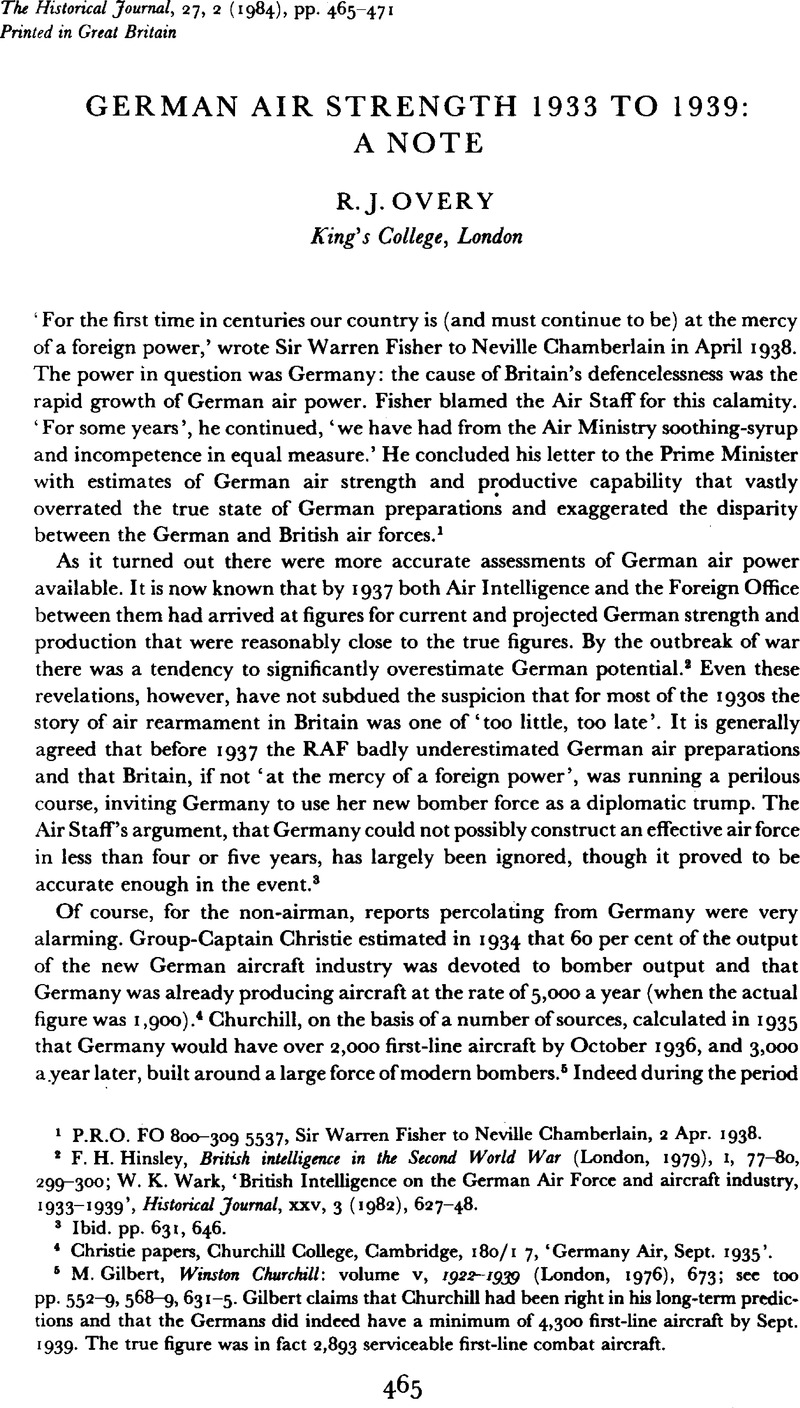Article contents
German Air Strength 1933 to 1939: a Note
Published online by Cambridge University Press: 11 February 2009
Abstract

- Type
- Communications
- Information
- Copyright
- Copyright © Cambridge University Press 1984
References
1 P.R.O. FO 800–309 5537, Sir Warren Fisher to Neville Chamberlain, 2 Apr. 1938.
2 Hinsley, F. H., British intelligence in the Second World War (London, 1979), I, 77–80, 299–300Google Scholar; Wark, W. K., ‘British Intelligence on the German Air Force and aircraft industry, 1933–1939’, Historical Journal, xxv, 3 (1982), 627–48CrossRefGoogle Scholar.
3 Ibid. pp. 631, 646.
4 Christie papers, Churchill College, Cambridge, 180/17, ‘Germany Air, Sept. 1935’.
5 Gilbert, M., Winston Churchill: volume v, 1922–1939 (London, 1976), 673Google Scholar; see too pp. 552–9, 568–9, 631–5. Gilbert claims that Churchill had been right in his long-term predictions and that the Germans did indeed have a minimum of 4,300 first-line aircraft by Sept. 1939. The true figure was in fact 2,893 serviceable first-line combat aircraft.
6 The quotation is from the Christie papers, 180/17. On heavy-bomber plans see Overy, R. J., ‘From Uralbomber to Amerikabomber: the Luftwaffe and strategic bombing’, Journal of Strategic Studies, I (1978), 156–65Google Scholar.
7 These are available in Webster, C. and Frankland, N., The strategic air offensive against Germany, IV (London, 1961), pp. 501–4Google Scholar.
8 Schliephake, H., The birth of the Luftwaffe (London, 1971), p. 70Google Scholar.
9 Air Ministry, Rise and fall of the GAF (London, 1946)Google Scholar: Richards, D., The Royal Air Force 1939–1945 (London, 1974), 1, 7Google Scholar.
10 Green, W., Warplanes of the Third Reich (London, 1972), pp. 25–31, 264–6, 421–2Google Scholar.
11 Ibid. p. 407.
12 Homze, E., Arming the Luftwaffe (Nebraska U.P., 1976), pp. 249–50Google Scholar; Overy, R. J., ‘Hitler's war and the German economy: a reinterpretation’, Economic History Review, 2nd ser., xxxv (1982), pp. 276–7, 280–ICrossRefGoogle Scholar.
13 See the assessment in Murray, W., ‘German air power and the Munich crisis’, in Bond, B. and Roy, I. (eds.), War and society, (London, 1976), vol. IGoogle Scholar.
14 Gundelach, K., ‘The German air force’, Aerospace Historian, XVIII (1971), 88Google Scholar.
15 Quoted in Gilbert, Churchill, v, 559.
- 3
- Cited by


